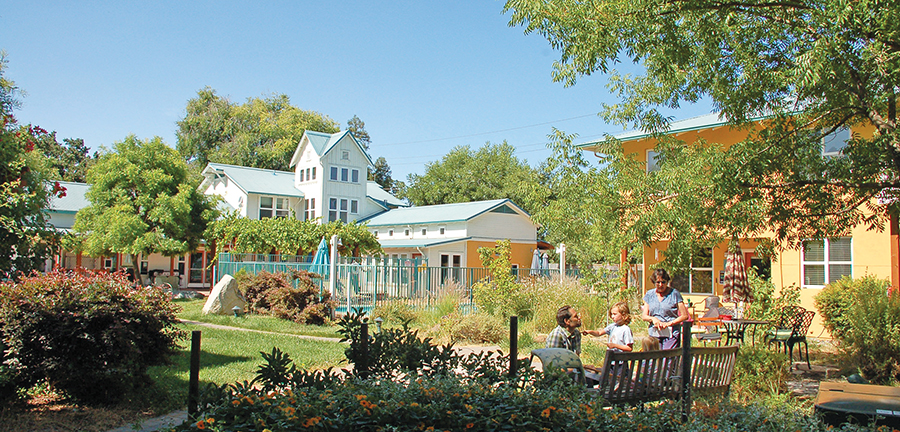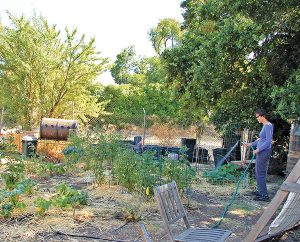
In addition to 32 individual and varied housing units, Pleasant Hill Cohousing includes a shared Common House (the large white building) with a kitchen, dining room, sitting room, laundry, kids room, teens room, crafts room, guest rooms, and bathrooms. Photo by Alec MacDonald.
The Bay Area housing affordability crisis is changing single-family home ownership as residents explore variations on the dream, turning to creative solutions like cohousing that offer community and cost-of-living advantages.
Cohousing is an arrangement in which people live in a group of private homes and benefit from shared spaces like workshops, gardens, and a common house that threads people together with a kitchen and dining area. The design emphasizes collaborative settings where people get to know and support each other, a stimulating environment gaining traction even though it can be challenging to develop.
The concept was born in Denmark in the 1970s and has spread steadily across the U.S., with the established cohousing community tally at 165, according to the U.S. Cohousing Association. Kathryn McCamant and Charles Durrett coined the word “cohousing” in the late ’80s after they spent time in Denmark. Their firm McCamant & Durrett Architects has helped design more than 50 of these high-functioning neighborhoods in the U.S., both senior and intergenerational.
A number of its projects are in the Bay Area in places like Cotati, Benicia, Berkeley, Oakland, Emeryville, Santa Rosa, Pleasant Hill, Mountain View, and the upcoming C Street Village in Novato.
“I would argue that community is part and parcel to having a viable society,” said Durrett, who has lived in cohousing himself for 25 years.
“Personally, I enjoy it a lot,” he said. “I seem to have so much more free time. When it’s my turn to cook, it takes me three to four hours but then I don’t have to do that for the rest of the month.”
Cohousing communities typically form among like-minded groups of people with common values and a clear vision toward creating an “intentional community,” a term that includes cohousing in addition to other shared arrangements.
Homebuyers may be more willing to consider such arrangements these days, as many single-family homes are priced out of reach. Families and empty nesters can find added value in intentional communities, with activities and social support to help them cope with all the pressures — economic and otherwise — of raising kids and aging.
The single-family home is “not stepping up and meeting the needs we have over the life of a family,” said Loni Gray, an accessory dwelling unit (ADU) expert and housing consultant.
Awareness about these shortcomings is seen at the public engagement level. East Bay Cohousing, which provides cohousing information and support for people seeking opportunities, recently crossed the 4,900-member mark.
“There’s a hunger out there,” said Raines Cohen, a Berkeley Cohousing resident who runs the group. Raines also serves as Northern California regional organizer with Cohousing California, an umbrella group aimed at creating green intentional neighborhoods.
Cohousing is distinctive because its residents bear the responsibility for the community’s creation and long-term health. Cohousing communities are self-managed, operate by consensus, and employ their collective energies and wisdom, Cohen said. They rely on committees to cover all the financial, maintenance, landscaping, and other needs. The legal structure is typically a homeowners association in which everyone contributes dues that pay for meals, utilities, and other expenses.
What most people discover is that several years of sweat equity are often necessary to build new attached or detached homes together (although sometimes cohousing is born through redevelopment of an existing structure).
Many groups employ consultants who walk them through design, development costs, financing obstacles for getting loans, and regulatory challenges related to zoning.
“To make it happen requires a lot of focus,” said John Caye, co-founder of C Street Village, where he and his family will live when it opens in 2021.
Location plays a big role in the early decision making, especially as it relates to the potential to walk, bike, and take public transit.
“When I put together a site location with a group… I generate the criteria with them,” Durrett said. “They come up with eight to a dozen criteria. If they don’t bring up transportation, then I challenge them to consider those options, too.”
Homeowners in C Street Village settled on a 2.7-acre site near the Hamilton Sonoma Marin Area Rail Transit (SMART) station. The site will feature 40 condominiums (including three- and four-bedroom townhomes and two- and three-bedroom flats) and eight “carriage” homes that are one bedroom or studio size.
The project will include 20 percent of the homes at affordable pricing. The exact units and mix are subject to City of Novato approval.
Home prices will range from $550,000 to $950,000, a spread that’s similar to the listed price of single-family residences in the area. Those prices, which include common amenities and shared spaces, are subject to change based on current market and building conditions, according to the group’s website.
C Street Village’s hub will be its 3,700 square-foot club house. It will include a catering kitchen, a great room with dining tables for sharing meals, an all-purpose room for classes or yoga, a kids room, an outdoor terrace with a barbecue, a sauna, and a hot tub. Residents will have private kitchens and other facilities in their own homes. But they’ll also share five or six meals a week, taking turns cooking and cleaning.
Splitting these responsibilities can save time and money over the long term, as does trading childcare and sharing resources like bikes, lawnmowers, and cars.
Cohousing is “a great alternative for folks looking for community,” said Caye, who previously lived in Blueberry Hill Cohousing near Washington, D.C.
Studies show that people living in cohousing — families with children, singles, couples, and retirees — benefit physically and mentally from the social inclusion of communal living.
“We’ve got a variety of ages, from negative six months to over 80,” said Michael Coleman, an original owner in Swan’s Market Cohousing, a 20-unit community created in the retrofitted 1917 Swan’s Market building in the historic Old Oakland neighborhood.
At Pleasant Hill Cohousing, all the front doors open to each other by design and homes are connected by a pathway that is pedestrian friendly and safe for kids, according to Marian Shostrom, whose family was the first to move in 18 years ago and now lives among 31 other households.

Along with a garden, other amenities at Pleasant Hill Cohousing include a swimming pool, hot tub, patio arbor, workshop, bike sheds, and play structure. Photo by Alec MacDonald.
Still, the togetherness might not feel right for everyone, especially people who place a premium on privacy or have a hard time compromising. Inevitably sources of conflict come up. Not everyone is going to have the same tastes, routines, or even parenting styles.
“We do have values and vision statements that we do go back to when controversial issues come up,” Shostrom said.
Individuals on Pleasant Hill Cohousing’s interest list are “encouraged to come to a meal, social event, or meeting and get to know people so they aren’t surprised about who we are and what it might be like to live here,” Shostrom said.
Regional policy aimed at housing production could result in a greater variety of housing types down the road. Last year, the Metropolitan Transportation Commission and the Association of Bay Area Governments outlined recommendations for housing development that’s affordable, near public transit, and allows for more density. These changes could help boost supply of duplexes, triplexes, and other “missing middle” housing types.
The agencies’ recommendations don’t call out alternatives like cohousing specifically. But the challenge before many communities is to consider the shifting role of the single-family home and whether existing codes and regulations are preventing creative solutions to housing formation, said Erika Sklar, operations manager with the City of St. Helena. She wrote a white paper last year for St. Helena officials that included discussion of zoning amendments aimed at cohousing and clustered development.
“Let’s not wait for a community of people to come to us and say, ‘We want to do something creative,’” Sklar said. “Let’s write the zoning code so it allows for that creativity to flow through.”
There is some recent movement toward development with intentional community aims. Start-up housing provider Starcity plans to build 803 private, furnished coliving high-rise units in San Jose that will be connected by a common hallway and other shared space. A separate San Francisco development will have 270 coliving units. Both are coming to the Bay Area in 2021 and targeting professionals seeking affordable rent.
ADUs, commonly known as “granny flats,” are increasingly being placed in the backyard of single-family residences to cost-effectively create more space to house aging parents or grown kids. In Healdsburg, a small community with an aging population, the city council recently increased the maximum size of ADUs to 1,200 square feet to increase affordable housing options.
City officials are taking the approach of “everything is on the table when it comes to housing,” said Mayor David Hagale.
“Cohousing is part of the discussion, but not the focal point,” Hagale said. “Like most cities, we are dealing with zoning ordinances done before cohousing was around.”
Cecily O’Connor covers transportation for the Monitor.

